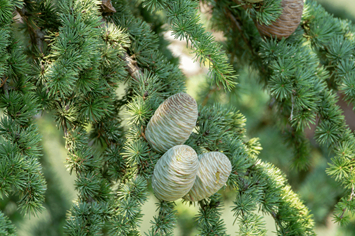There’s a feeling you get when you find the perfect evergreen -- whether it’s for a focal point in your landscape or a holiday tree to decorate. You can almost picture it draped with sparkling lights or highlighted with snowflakes.
The deodar cedar tree may just be one of those evergreens. It's gracefully drooping branches that come in that conical shape are not only stately and organized, but also elegant.
Its name evolves from the word devadaru, which is Sanskrit for “timber of the gods.” And that’s not only in reference to its gracious aesthetics. This tree’s wood has supported the structures of temples or palaces in places like India and Afghanistan. The Egyptians even used deodar cedar wood to build sarcophaguses for their mummies.
Looking for one of these trees to add some majesty to your home landscape? Here is how to identify and care for deodar cedar trees.
How to Identify a Deodar Cedar
The deodar cedar tree is well-known for its widespread swooping branches. Young trees begin in pyramidal shapes and then, as they mature, their branches become broader and more horizontal with flat tops. In fact, these cedar branches can spread approximately 10 to 15 feet outwards from the trunk.
In their native habitat, these trees can grow to be 150 feet tall, growing approximately 3 feet a year. But in the landscape, they can normally reach 20 to 50 feet tall.
How long do deodar cedar trees live? They can live to be hundreds of years old.
Deodar Cedar Identification By Needles
Looking more closely at the deodar tree needles, you’ll find they are 1 to 2 inches long, blue-green to gray-green, and fine to the touch. This greenish-silver foliage can make an attractive privacy screen.

These needles remain on the tree for three to six years before being replaced by new ones.
What Do Deodar Cedar Cones Look Like?
If you’re using the cones from a deodar tree to help you identify it, you’ll find both male and female cones.

The male cones are usually found on the tree’s lower branches, and they give off pollen in autumn. Female cones grow at the tips of upper branches, and the wind brings the male’s pollen to them for pollination. Those pollinated female cones grow in spring and summer. Green cones become brown as they mature, reaching 3 to 6 inches long. Every scale on the cones has two seeds, which are released when they are mature -- after about 12 to 13 months. Then the seeds germinate and grow in late spring after overwintering in the soil.
Deodar Cedar Tree Bark

If you take a look at a deodar cedar tree’s bark, you’ll find it’s dark gray, becoming more scaled as it ages.
Mature trees have thick trunks measuring 3 meters (need to be consistent with measures, earlier with the height you used feet) in diameter.
Deodar Tree Wood Uses
There are many deodar tree wood uses. Not only is the wood used in carpentry because it has a grain that polishes well, but it has been used for building bridges and even making pencils.
The deodar tree also has medicinal uses. Its wood, resin, and bark are reported to have anti-inflammatory and anti-cancer properties.
How to Care for Deodar Cedar
- Grow zones: Deodar trees grow well in hardiness zones from 7 to 9
- Where to plant: The deodar cedar can grow in a variety of soil types -- loam, sand, and clay. But despite the type of soil, it prefers that it be well-drained and slightly acidic. Plant a sapling in the early spring once the ground has thawed or in the fall once the plant has gone dormant as it prepares for winter. Remember, it will need more sun and water in the spring vs. the fall to grow well. Dig a hole two to three times as wide as the tree’s root ball and add 25 percent compost to the soil to help it drain.
- Height/spread: Give a deodar cedar tree some room to grow. As a moderate grower, it can reach 40 to 50 feet tall and 20 to 30 feet wide.
- Sunlight: While this tree can tolerate partial shade, full sun is best. Of all cedars, the deodar tree has the best tolerance for heat and humidity.
- Flowering dates: Deodar cedars are non-flowering trees.
- Best time to prune: This tree is fairly low-maintenance. The only deodar cedar pruning typically necessary is to remove diseased, damaged, or dead branches before new growth begins in spring.
- Deer resistance: Most conifer trees like the deodar cedar are safe from deer munching except for Douglas fir and yew. There may be instances during extreme cold weather events where deer may browse these trees.
Potential Threats (pests and symptoms)
When it comes to insects, you can sometimes find aphids on deodar cedar trees, though infestations don’t typically impact trees enough to injure them. The aphids do produce a substance called honeydew that falls to the nearby areas, making everything a bit sticky. You may want to reach out to your local arborist to help you take care of any pests should an infestation occur.
If the soil is soggy and doesn’t drain well, root rot can also occur. Planting this tree in the right place can help it live a long and healthy life.





